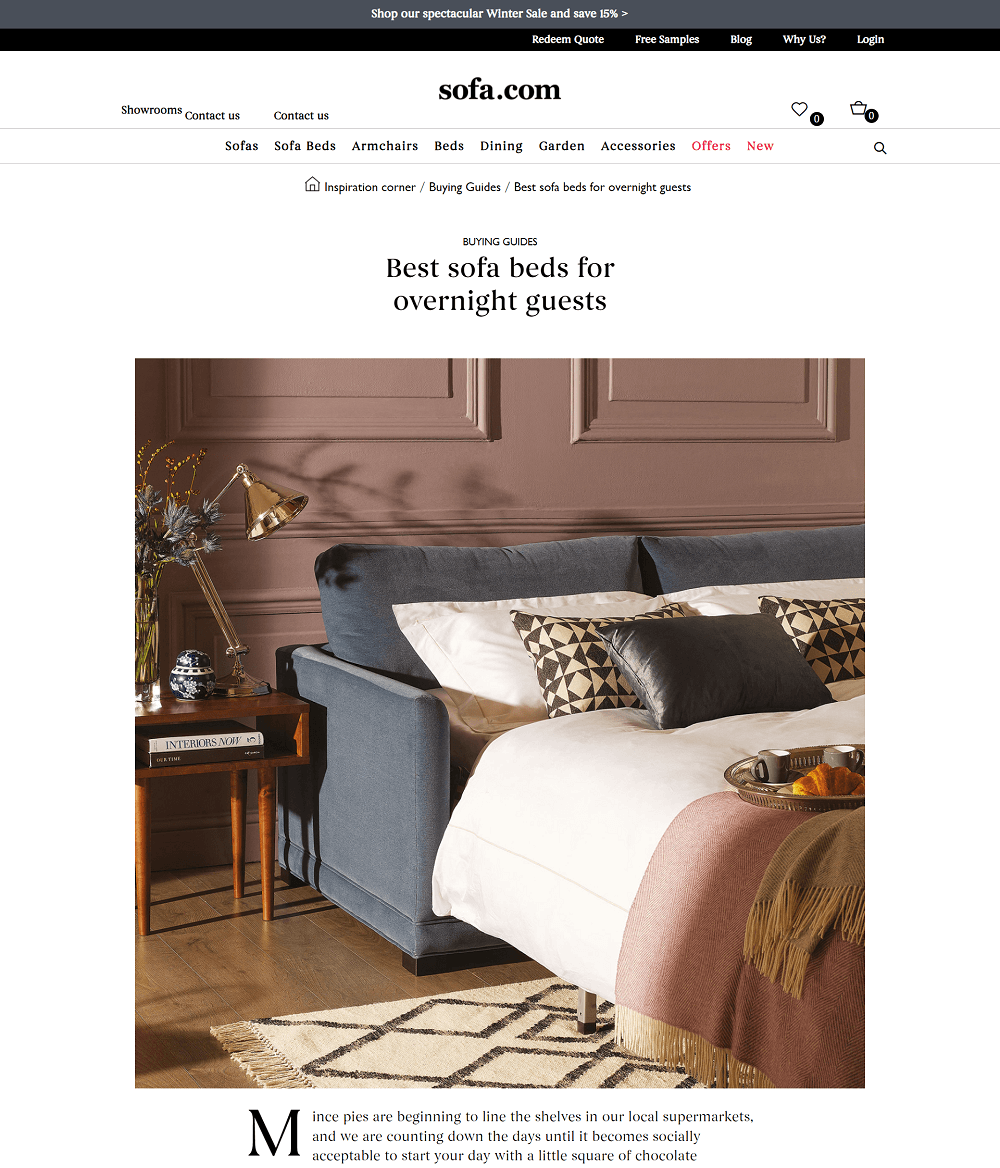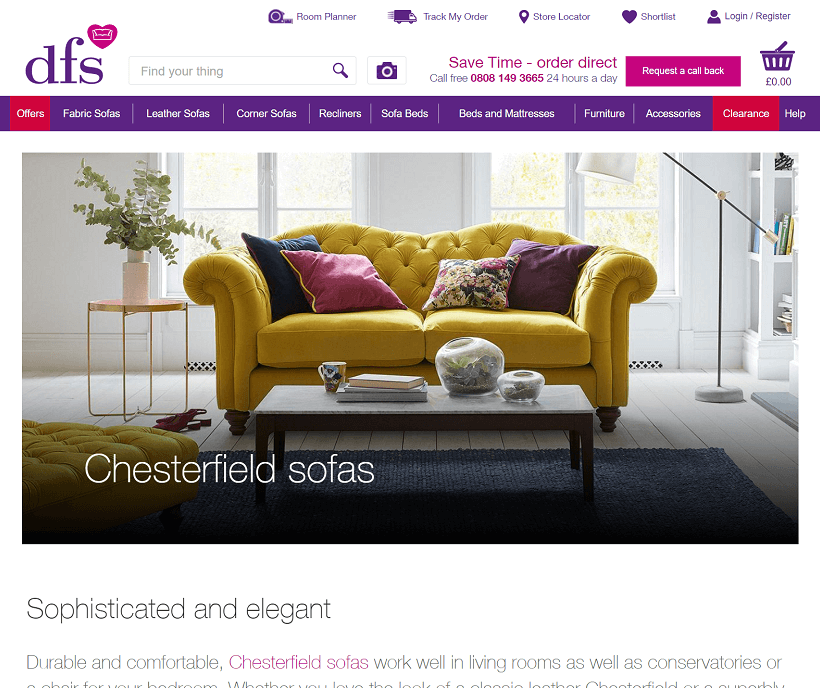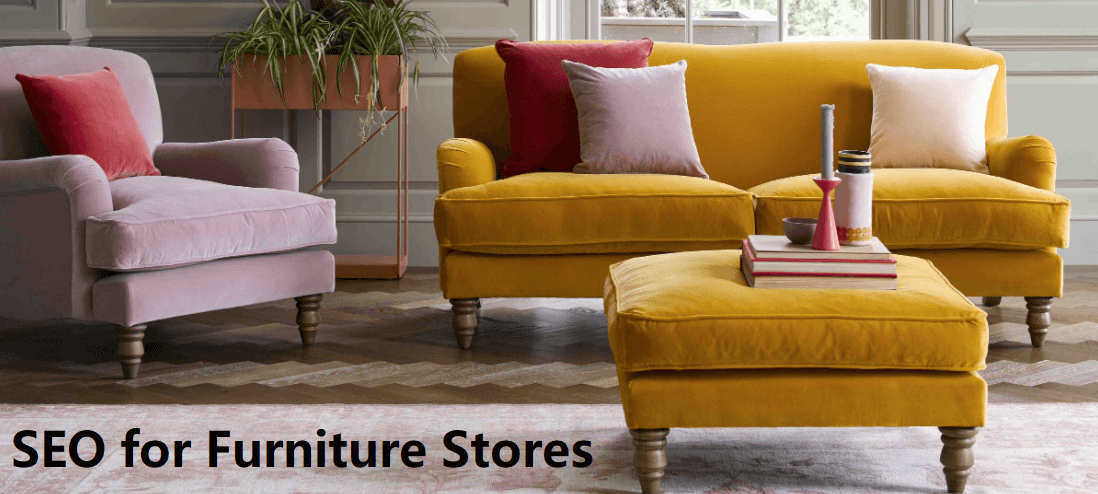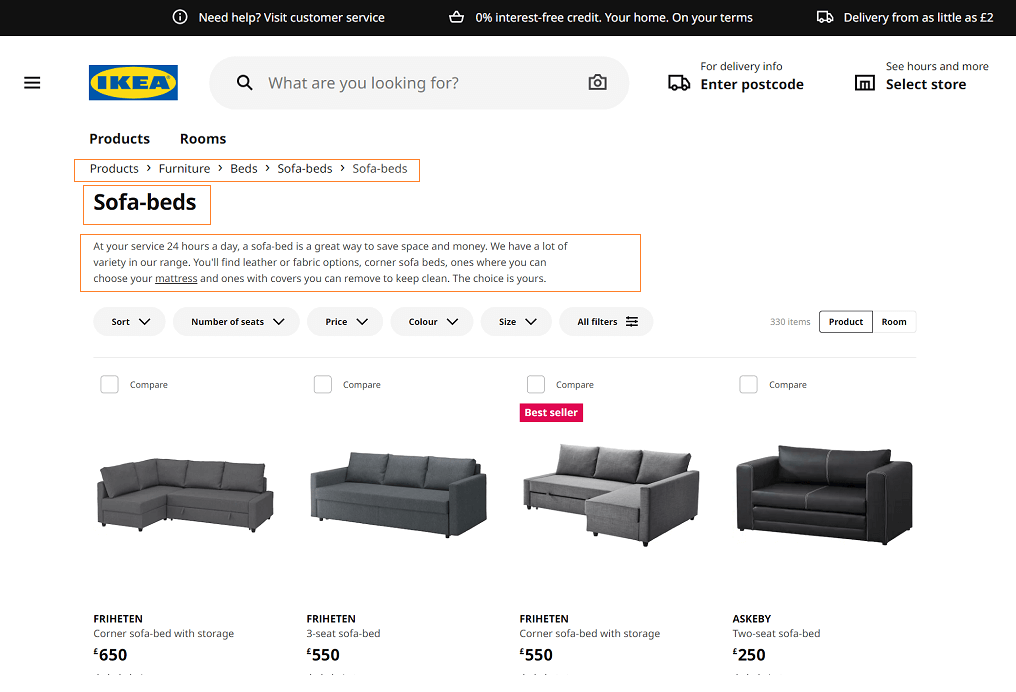Online furniture and bedding sales are a billion-dollar industry and will continue to grow bigger. Since the pandemic has affected in-store sales, the online channels especially Organic and Paid channels have seen an increase in contribution to the total furniture and bedding sales and this is predicted to continue to increase over the coming years.
Online Furniture is one of the most competitive categories within Homeware when it comes to SEO presence. The SERPs are dominated by leading brands such as sofa.com, sofology.co.uk, dfs.co.uk, scs.co.uk, sofa-club.co.uk, ikea.com, argos.co.uk, made.com, furniturevillage.co.uk, dreams.co.uk, dunelm.com, habitat.co.uk, bensonsforbeds.co.uk across a variety of competitive terms such as sofa, sofa bed, corner sofa, double bed, king-size bed, armchair and more. Before you start building your SEO and content strategy for your furniture brand, it’s essential to understand your audience/buyer personas.
Let’s look at some of the big players in the UK homeware industry that dominates by share of voice in SERPs. Below is the recently released leader board released by PI-Datametrics for the homeware Industry showing brands that dominate in Google UK.

SEO for Furniture Stores
So, what’s the objective of this furniture SEO guide?
- Improve SEO for furniture stores to improve visibility for furniture & homeware search terms on major search engines.
- Show up for your brand name for “furniture term + city” searches in your local area.
- Make some savings from otherwise expensive high CPC furniture search terms. An increase in organic traffic and better rankings would mean increased ROI.
STEP 1: Furniture Keyword Research
Keyword research is the most important step when it comes to eCommerce Furniture SEO. The keyword research will depend on the type of the Furniture website and your target audience. Your website could be in the market for one or more of the below categories and the objective here is to optimise for the high-volume keywords relevant to customers in that market;
- Furniture keywords related to a specific category such as Bedroom, Sofa, Tables, Chairs etc.
- Furniture keywords related to a functional use case such as Garden furniture, furniture for the home, living room, patio, kitchen, office, outdoor, dining, or used for commercial and hospitality.
- Luxury furniture keywords for high-end premium consumers.
- Bespoke or made-to-measure furniture keywords.
- Furniture keywords for budget-conscious customers such as second-hand/used furniture, cheap/affordable, and wholesale furniture terms.
- Environmentally-friendly sustainable furniture.
- Customers looking for furniture made of a specific material such as Wooden, Oak, Leather, Aluminium etc or a specific colour such as red, blue, grey furniture etc.
- Antique, vintage & retro furniture websites.
- and the list goes on…
Based on the target audience, this step involves identifying the target search terms to feed into your SEO & Brand content strategy.
Let’s take a look at some of the top search terms in the Furniture industry. According to SEMRush, in Google UK, the keyword “Sofa” gets around 360K searches per month. “Beds” gets around 135K searches per month. “Table” gets around 40.5K searches per month. “Char” gets around 90.5K searches per month.
Below is the 12-month seasonality trend for top terms within key furniture categories such as Sofas, Sofa beds, Armchairs, Beds, Dining and Garden furniture. keywords. The keywords were gathered using a combination of SEMRush & Google Keyword Planner. Ahrefs, Soovle, UberSuggest, KeywordResearch.io and Moz Keyword Explorer are other tools you could use to perform keyword research.
Sofa SEO Keyword Research

Click here to view the complete list of Sofa SEO keywords.
Sofa Beds SEO Keyword Research

Click here to view the complete list of makeup SEO Beds SEO keywords.
Armchairs SEO Keyword Research

Click here to view the complete list of Armchairs SEO keywords.
Beds SEO Keyword Research

Click here to view the complete list of Beds SEO keywords.
Chairs SEO Keyword Research

Click here to view the complete list of Chairs SEO keywords.
Garden/Dining Furniture SEO Keyword Research

Click here to view the complete list of Garden/Dining Furniture SEO keywords.
Tables SEO Keyword Research

Click here to view the complete list of Tables SEO keywords.
Stools SEO Keyword Research

Click here to view the complete list of Stools SEO keywords.
Shortlist the best high-value keywords that your potential customers might be using from your keyword research. The search volume, competition, keyword relevancy and intent are some of the factors to consider when identifying the best keywords for your furniture brand.
STEP 2: Have a Solid Keyword Driven Content Strategy
If we start analysing the purchase behaviour of furniture buyers, we can see that today’s consumers are presented with several options to purchase furniture. If they want the convenience of just looking at a product, they can go to the website, and if they want to interact with a sales rep, either at a trade show or in-store, they can choose to do that.
Whatever medium they use or wherever they are in the buying process, the customer may want to find additional information to help with their purchase decision. What this means is that your customers are expecting the furniture e-commerce websites to have a lot of information to answer their product questions or explain product trends.
Your content must guide the furniture buyer throughout the buying process. Shoppers are purchasing more furniture products online than ever before because they want to research online before making a purchase. So, there’s a huge opportunity for furniture brands to provide good content at all stages of the purchase funnel to truly connect with their audience and increase engagement with consumers.
The data from the keyword research step is very valuable in coming up with an effective content strategy to address search intent. The keyword research helps the furniture brand owner understand what is it that buyers really want, what’re they expecting etc.
Furniture SEO Content Strategy Tips
- Get in front of the shoppers early in the research phase. Have a dedicated slot on the homepage to link to your content. Your content could be things such as information on sales trends, and product trends like what’s selling well in a particular region or in a particular type of store. That’s the type of information that your buyers are expecting to know.
- Identify the content pillars that will form the basis of your ongoing content. Remember that to retain audiences and to keep them coming back, you’ll need to create a brand personality, tone, and atmosphere that is familiar to your fans. That’s why creating content pillars and sticking to them will enable you to create the right content that stands out as well. Examples of content pillars for the furniture industry are;
- Sofas
- Recliners
- Sofa Beds
- Chairs
- Tables
- Storage
- Beds & Mattresses
- Dining
- Garden
- Decor & Accessories
- Carpets & Flooring
- Lighting
- Textiles
- Furniture by Room (Dining, Bedroom etc)
- Trends / What’s Trending
- Brand events & shows, behind-the-scenes
- Product Picks
- Tips, How-To & Buying Guides: These I find most useful for eCommerce sites as they are the sort of content that help customers with pre-and post-purchase. Buying guides are great for pre-purchase and DIY posts to How to care for furniture sort of posts act as great sources of information for post-purchase.
- Create content to answer user content by targeting your keywords in all your content pieces. Your content should give the customer a better understanding of the product and go off based on the information to make a purchase decision.
- Optimise your internal linking to link to the key furniture product categories and pages from within your blog content.
- Create content with social channels in mind. Add lots of videos and images to your blog posts as visual content adds life to text-only content. Additionally, these assets can be shared on social media and YouTube and can link back to your site.
Let’s now look at the top-performing blog posts of popular online brands
 One of Sofa.com’s top-performing article targets the term “best sofa beds” which gets around 6,600 searches per month.
One of Sofa.com’s top-performing article targets the term “best sofa beds” which gets around 6,600 searches per month.
 One of DFS.co.uk’s top-performing articles targets the term “chesterfield sofas” which gets around 60.5k searches per month.
One of DFS.co.uk’s top-performing articles targets the term “chesterfield sofas” which gets around 60.5k searches per month.
 One of SCS.co.uk’s top-performing articles targets the question “What is a Modular Sofa” which gets around 210 searches per month
One of SCS.co.uk’s top-performing articles targets the question “What is a Modular Sofa” which gets around 210 searches per month
From the above examples, what’s common is the brand’s top blog pages focus on high-commercial intent keywords via how-to’s or informative advice posts. It’s important for every brand to develop original, shareable, engaging content that gets linked automatically because of its value.
STEP 3: Perform a Technical SEO Site Audit
Furniture eCommerce sites are usually large websites consisting of thousands of pages with several products which is precisely why It is essential to have a website that is implemented correctly from a technical perspective. What really matters for your website is, that before doing any SEO work, you need to do a comprehensive audit to determine where you’re currently at. Shotgun approaches don’t work in the long run. Tools like Botify, Deepcrawl, ScreamingFrog, Oncrawl, Sitebulb, etc let you perform technical SEO audits. A few things that need to be considered to improve your visibility online are;
- Having the right site structure affects the website’s visibility in a positive way.
- Fast site load speed is vital to any website as it improves user experience and is also one of the ranking factors. Google’s Page Speed Insights can provide a good insight into your website’s page speed metrics, and the issues and actions you need to take to improve your page speed scores. There are other tools like WebPageTest, GTMetrix, Dareboost etc that can be used for the same purpose.
- Pay attention to Core Web Vitals as these metrics can influence your rankings to an extent. Start thinking about page speed in everything that your designer and developers work on. Below is a core web vitals comparison for sofa.com, sofology.co.uk, and dfs.co.uk at the time of publishing this article (Dec 2021).

- Fix broken links (404 pages). Check out the newly refreshed Google crawl stats interface within your search console to spot some of the crawl issues encountered by Googlebot.
- Ensure your site is designed with mobile-first and mobile-friendly principles in mind.
- You can’t avoid large brand images on a furniture website. Ensure they are well compressed using lossless compression and create images of the right sizes. If you’re making videos or taking really high-quality photography, you want to make sure they are well-optimised for page speed.
- Implement schema on your site to provide additional information for search engines to understand your pages better. Furniture websites typically have schema implemented on product pages and breadcrumbs on product listing pages.
 Example of a SERP for a Furniture product that stands out displaying additional product information such as product ratings and reviews, stock availability and price. Customers are more likely to make a purchase from a site that has high ratings.
Example of a SERP for a Furniture product that stands out displaying additional product information such as product ratings and reviews, stock availability and price. Customers are more likely to make a purchase from a site that has high ratings.
Step 4: On-page Optimisation
You want to make sure that your furniture buyers have the ability to go to your website to do that initial research and get what they’re looking for. The purpose of the site visit could be either researching price, researching product information or making the purchase. Let’s look at an example of a product lister page on IKEA. The page below ranks in position 1 for “sofa beds” on Google UK.
- The page has easy to read keyword-friendly URL with the target term “sofa beds” – https://www.ikea.com/gb/en/cat/sofa-beds-20874/
- The page is well-optimised with an informative page title & meta description using the target terms.

- The product listing page is optimised with a copy blurb and a page heading. Internal links are present in the body copy to related categories. Make sure you optimise all your category pages with the right keywords. If you are a new brand, produce content to target long-tail keywords before moving on to broad and highly competitive search terms.
- You should also optimise your product description pages with relevant headings and add lots of details about the product talking about its benefits. Here’s a great example from Furniture Village, with an optimised product description, helpful visuals (photos & videos) and a reviews section to convince the visitor to purchase. Whether it be multiple product imagery or whether it’s that information about feel, specs or delivery times, all of that information must be clear to help the buyer visualise the product from the comfort of this home. Videos and 360-degree views can give an example of that product in a real-world space. It basically just allows your customer to have a similar experience to the showroom experience.
- Include alt text for your website’s images.
Focus on user experience metrics, particularly bounce rate. When a user reaches a page on your site from the SERPs and then immediately goes back to the SERPs because they didn’t like what they saw, this typically signifies that the users didn’t find what they were looking for. They didn’t get an answer to their search query and had to go back to Google in order to find something.
Step 5: Off-page Optimisation
Double down on backlinks. Google still cares a lot about the authority of your site and hence backlinks are one way to figure out how much others trust your website. There is a correlation between higher rankings on pages with high-quality backlinks. Develop a long-term white-hat link-building strategy to obtain links from authoritative websites. Use digital PR techniques to create well-researched statistical-based content pieces and reach out to journalists, trying to get published in the major news publications.
- Don’t just build links to the homepage. Your links profile must also include deep links pointing to your product lister and product description pages.
- Competitor backlink research: Use tools like Ahrefs, Majestic, SEMRush, Open site explorer or Backlinko to spy on competitor backlinks.
- Outsource your link building, Digital PR and influencer outreach to a specialised agency as this is a full-time job while you focus on the on-page and the tech SEO elements.
Step 6: Local SEO
If you own a furniture storefront and want to appear for brand name + city/near me searches, then there are a few things to consider to improve your local SEO ranking. Furniture businesses in bigger cities are going to probably require some different strategies than furniture stores in smaller towns.
One of the most important things though for furniture businesses is, no matter where you’re located is understanding how users search on Google. When people are looking for furniture stores, this is usually how they search – “furniture stores near me” / “furniture stores in oxford street” etc. The very first thing that shows up is what’s known as this Google Local Pack where only three businesses can rank organically.
So, what do we need to appear on the local pack?
Set up a Google Business Profile (formerly known as Google My Business) account for your store locations. This is required if you want to appear on the Google local pack for near me or brand local searches. The Name, Address and Phone number usually referred to as NAP details are required information for every business to be set up correctly on GMB. A lot of businesses have inconsistent name, address and phone number information across the internet.
Having just the NAP details does not guarantee you listing on the local pack. You’ll need to optimise each of your Business Profile listings with additional information. You can enrich your GMB listings by adding photos, optimised business descriptions targeting your high-volume keywords, adding relevant attributes, setting the right business listing category, adding products and services, showcasing your reviews and social channels and a ton of other things. You need to do a comprehensive local SEO audit of your website to determine which strategies are going to be most important for your business.

I hope this gives you a good starting point to improve SEO for your furniture store online. If you are a furniture brand looking for SEO consultancy, Contact me today!


